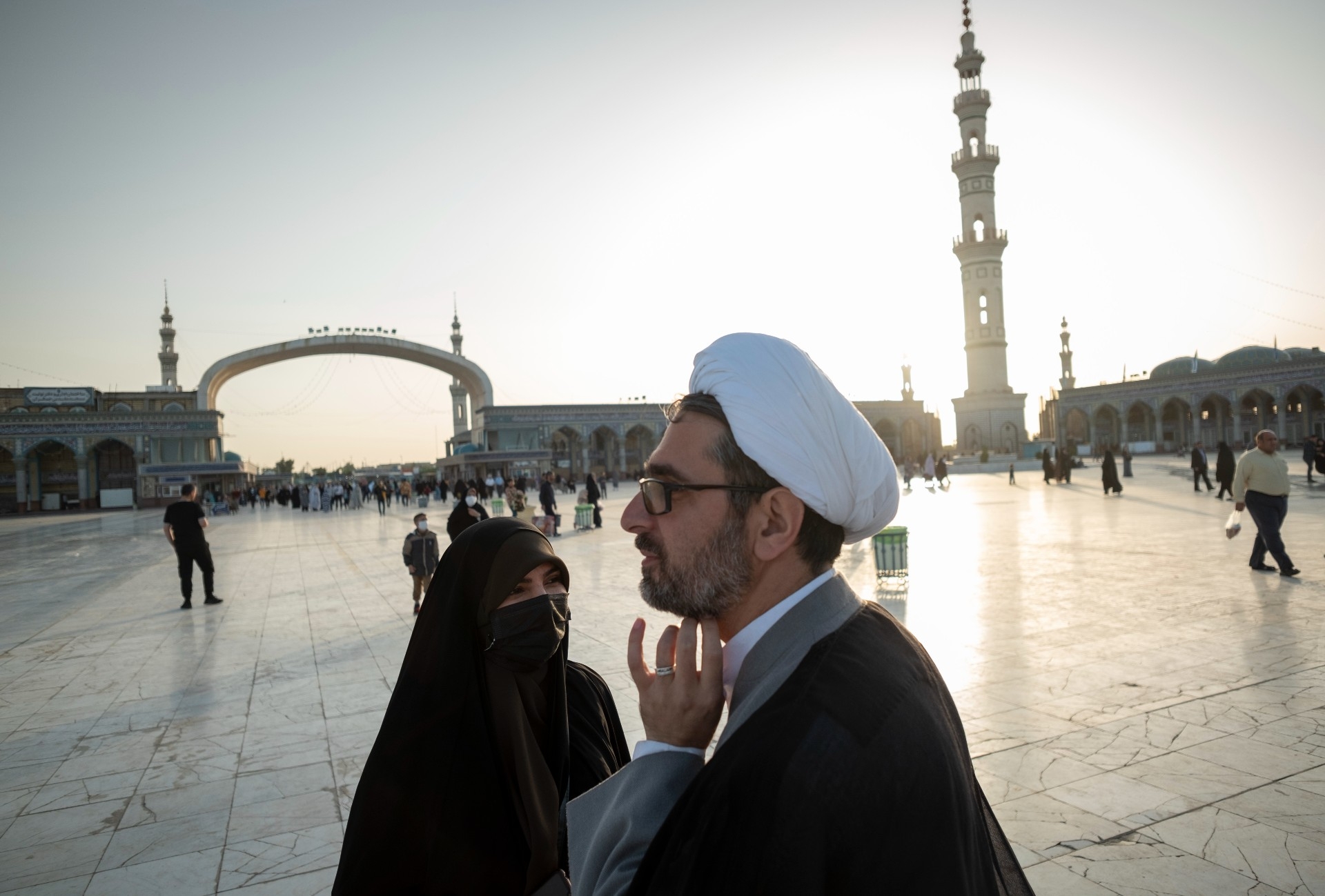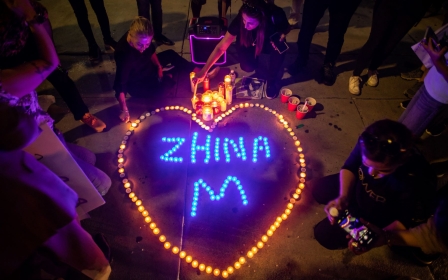Mahsa Amini: Iran's Qom clerics draw ire for studious silence over protests

Iran is in uproar. The death of 22-year-old Mahsa Amini, apparently at the hands of Iran’s so-called “morality police”, has driven people onto the streets in rolling protests against the draconian measures many, particularly women, are forced to live under.
The demonstrations are widespread and drawing support from many different corners of society - as well as condemnation and a violent crackdown that has so far killed at least 41 people.
It’s the burning subject that’s impossible to ignore. Yet in the holy city of Qom, which has witnessed its own protests in recent days, much of the Shia clergy from which the Islamic Republic draws a great deal of its legitimacy has been conspicuously silent. Other clerics have thrown their weight behind the establishment.
The silence or opposition in the face of widespread sympathy for women tired of being ordered what to wear, or harassed by the police, has many Iranians believing the country’s grand ayatollahs risk losing public trust.
New MEE newsletter: Jerusalem Dispatch
Sign up to get the latest insights and analysis on Israel-Palestine, alongside Turkey Unpacked and other MEE newsletters
So far, Grand Ayatollah Asadollah Bayat-Zanjani has been the only senior cleric to vocally criticise the “morality police”, which he described as illegal and against religion.
Without directly mentioning the compulsory hijab law, which protesters are demanding is removed, Bayat-Zanjani said nobody should be forced to follow Islamic values.
Though senior, Bayat-Zanjani is nonetheless known to favour Iran’s reformist politicians, who are opposed to the current principalist government and want the Islamic Republic’s strictest restrictions overhauled.
In response, principalists have attacked him and called for his prosecution. Without naming Bayat-Zanjani, Mojtaba Zolnouri, an MP for Qom, said that some clerics had “provoked sedition” and “misled” the youth.
Meanwhile, Qom-based pro-establishment clerics last week staged a demonstration against the protests.
And Hossein Nouri Hamedani, a hardline grand ayatollah, condemned the protests, dismissing the demonstrators as not representative of the public, arguing the “real people” have always been “defenders of the Islamic Republic and the revolution”.
Despite the studied ambivalence or hostility displayed by much of Qom’s clergy over the protests, a cleric in the holy city told Middle East Eye that dissatisfaction with the establishment is growing.
“I think the majority in the Qom seminary, or at least a large percentage of clerics, are increasingly against the Islamic Republic, because it has both weakened Islam and clerics in the eyes of people,” he said. “This is while many clerics have no relations with the establishment and have been distancing themselves from its politics, as they don’t want to be seen as part of the Islamic Republic. However, people don’t know this, and I think clerics must be vocal.”
Like everyone MEE interviewed for this story, the cleric spoke on condition of anonymity, for security reasons.
The cleric, however, concedes that the clergy would be walking a fine line by criticising Iran’s mandatory hijab law, as wearing a headscarf is encouraged by all of the religious establishment.
“I understand it would be difficult for some critics in the seminary to talk against compulsory hijab, as hijab is considered something important in the religion, but they could have at least condemned the crackdown,” he said.
A historic role
The clergy have often played an important role in turning points in Iranian history. Whether the Iranian constitutional revolution in 1905 or the 1979 Islamic Revolution, grand ayatollahs have often appeared as pioneers of change and upheaval.
The status of clerics in Iran has historically allowed them to take critical positions that lent them more influence than the average Iranian. However, during the US-backed Pahlavi period, a large number of clerics and authorities in the Qom seminary believed they shouldn’t be involved in politics.
After the Islamic Revolution, clerics seized power, excluding others, including nationalists, leftists and religious nationalists. This resulted in clerics losing their previous position as critics of those in power.
Now, they had turned into rulers or supporters of what they perceived as the first Shia political system in centuries. Yet that new dynamic has come at a cost: over four decades there has been an eroding of popular support for the clergy.

2009 was a watershed in Iran’s post-revolution history, when millions of people marched in silence against the results of the presidential election.
Reformist candidates Mir Hossein Mousavi and Mehdi Karroubi alleged the vote was rigged and insisted that principalist candidate Mahmoud Ahmadinejad wasn’t the actual victor. A crackdown on the protests ensued, leading to the killing and arrests of many supporters of reformists.
At the time, the Qom seminary and grand ayatollahs were divided to a large extent, as many were afraid to raise their voices. However, some grand ayatollahs, like the late Yousef Sanei, didn’t stay silent, speaking out against the establishment, Ahmadinejad and the security forces’ brutal crackdown.
This resulted in the establishment moving harshly against Sanei. For instance, a clerical body in Qom tasked with vetting the marja (senior clerics who run seminaries), which is controlled by the establishment, declared that Sanei could no longer be considered a marja. However, this didn’t cause people to turn away from him. Instead, his popularity surged.
A cleric with deep knowledge of Qom politics told MEE at the time that grand ayatollahs Mousavi Ardebili and Musa Shobeiri Zanjani petitioned Supreme Leader Ayatollah Ali Khamenei on behalf of the protestors and Mousavi, but their attempts were futile.
Meanwhile, grand ayatollahs Abdollah Javadi Amoli and Ebrahim Amini, as well as senior cleric Reza Ostadi, gradually resigned as leaders of Qom’s Friday prayers, moves with significant resonance following the events of 2009. Friday prayer leaders are appointed by Khamenei’s office.
A journalist based in Qom told MEE: “Besides Ayatollah Sanei, most of the critics in the Qom seminary weren’t vocal, and this probably triggered people’s disappointment in the clergy and seminary in the first place.”
Dwindling trust
The emergence of Sanei’s criticism and likeminded clerics concerned the establishment, prompting authorities to try to bring the Qom seminary under full control.
Khamenei called for the seminary to become “revolutionary”, and hardline Ayatollah Mohammad Yazdi slammed the scholars and grand ayatollahs who refrained from vocally supporting the Islamic Republic or distanced themselves from politics.
That’s not to say there hasn’t been scope for criticism from Qom, depending on who is in charge. When widespread protests broke out in 2019 over the economic situation, conservative clerics lashed out at the reformist-backed government of Hassan Rouhani for increasing fuel prices.
'If they [clerics] cared for people, they would have objected to the crackdown on people and protesters'
- Qom-based journalist
Yet there were no criticisms of the violent crackdown on demonstrators, which left around 300 dead.
“The criticism of some grand ayatollahs against Rouhani at the time wasn’t for the sake of people, and it was in fact all in line with the establishment’s grand plan for weakening and undermining Rouhani and reformists,” the Qom-based journalist said.
“If they cared for people, they would have objected to the crackdown on people and protesters.”
According to a political commentator, the less independence the Qom seminary displays, the lower the public trust in the institution.
“If [the clerics] were vocal against the Islamic Republic’s behaviour against protesters, they would have at least saved themselves from being forgotten by people. However, even if the grand ayatollahs had entered the field, they couldn’t be accepted as a leader by protesters and people because the whole clergy’s reputation has been tarnished badly,” the commentator said.
“Despite Bayat-Zanjani’s moves, and many silent critics in the seminary, the whole clergy is being seen by people as a strong supporter of Islamic Republic.”
This article is available in French on Middle East Eye French edition.
Middle East Eye delivers independent and unrivalled coverage and analysis of the Middle East, North Africa and beyond. To learn more about republishing this content and the associated fees, please fill out this form. More about MEE can be found here.





